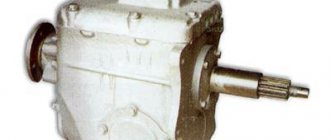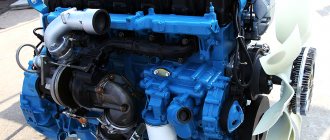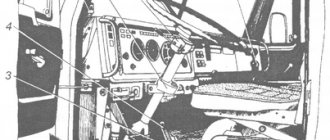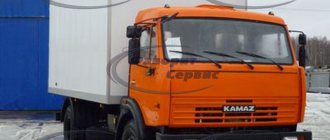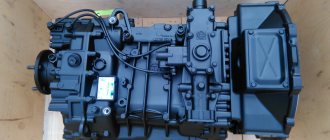Transfer case 65111-1800020-10 is installed on all-wheel drive KAMAZ 65111, 43118 trucks with a 6x6 wheel arrangement, which are used to move cargo and materials on road surfaces of any complexity. The unit is used to redistribute the forces of the internal combustion engine to the driving axles of the vehicle in compliance with a given proportion. Power is transmitted to axles located in the rear, middle and front parts of the machine. Conventionally designated as Euro 2, 3, as it has been used on equipment since 2008.
The truck has several modes of use:
- driving on rough terrain (off-road), a low gear is used;
- When moving on asphalt surfaces, high gear is used.
To prevent slipping on snow and ice, the transfer case 65111 is equipped with a differential lock, which acts on the drive axles of the vehicle.
RK 65111 used for off-road use can mechanically block the vehicle's drive axles as needed. This ability is used in cases where one of the bridges is stuck in the mud or has minimal traction, while the others have better traction. This ability resembles the operation of a differential. The vehicle's transmission is equipped with one or more sets of low gears, which are used in off-road conditions. Low speed modes are connected using a mechanical or electronic switch. In most cases, the operation of this mechanism is identical to the operation of the switch that controls the connection or disconnection of all-wheel drive (2WD, 4WD). Lower gears help the vehicle travel at significantly slower speeds while still operating within the engine's RPM power range. Thus, there is an increase in the amount of torque on the axles of the machine. These capabilities are used to overcome extreme conditions on dirt roads. The presented functional set is not installed on all all-wheel drive vehicles. Some very large vehicles, such as heavy equipment or military trucks, have more than one low loader.
RK 43114 was replaced by 65111
In order to increase reliability and increase service life, from June 1, 2007, the production and equipping of KAMAZ all-wheel drive vehicles with transfer cases 43114-1800020 was stopped. Currently, these machines are equipped with more reliable transfer cases 65111
-1800020.
Component parts RK 43114-1800020 are manufactured only as spare parts .
Applicability
The following KamAZ models are equipped with transfer case 65111:
- 65111 (Euro 4)
- 43114
- 43118
- 43261 (Euro 1, 2)
- 4350 (4x4)
- 43501 (4x4)
- 43502
- 5350 6x6
- 53501 6x6
- 53504 6x6
- 6350 8x8
- 63501 8x8
- 6450 8x8
Principle of operation
Activation of the switches blocks the access of compressed air to the pneumatic chambers, as a result of which the diaphragms take the required position. The motor power is distributed to the holders and satellites. When driving on a good dirt road, the satellites carry the gears of the mechanism with them and work as a single unit. When uneven road surfaces (off-road) appear, the functionality of the satellites changes; they begin to rotate around their axis and around the main axis. This consequence is associated with the difference in the travel of the bogie and the front axle and the appearance of differences in the rotation speed of the epicycle with the sun gear. To prevent both gears from being engaged, the design provides a lock that eliminates this possibility.
The differential is activated using a pneumatic chamber, and the clutch moves between the front axle drive system and the holder. The coupling is the connecting link between the presented parts. The resulting loads and forces are distributed between the bogie and the front axle. Distribution occurs proportionally according to the calculated scheme.
When the differential is unlocked, the load on the gearbox is completely eliminated. Thus, the service life of the mechanism is extended. The switched-on state of this device is required only under conditions of extreme loads (ice, mud, sand), when there is a threat to safe driving.
Lubrication of RK 65111 is carried out as follows: a certain amount of oil is sprayed, after which 5 liters are poured into the crankcase.
What are the types of malfunctions and how to recognize them
The cause of increased noise when the truck is operating may be a large gap between the gearbox gear and the PTO. The sealing gasket between the flange and the box must be at least 0.6 mm.
Self-switching off of the gear unit can indicate an unsatisfactory fit of the unit on the splines of the driven shaft.
The power take-off is not functioning and air is coming out of it. Possible rupture of the diaphragm pneumatic chamber/poor tightening of the components on the rod/damaged gear teeth/bent fork.
The mechanism does not turn on completely. Spring parts may break.
When disconnected, the control lamp lights up. The spring is broken/clutch teeth, shaft or gear are damaged.
The alarm indicator lamp does not light up. The fuse/light bulb is burned out/the diaphragm is damaged/the fasteners on the rod are loose/the solenoid valve is broken.
The power take-off does not turn off. Check the serviceability of the electro-pneumatic valve in the transmission unit of the truck.
Oil leaks at mounting points. The bolts are loose/the gaskets or copper washer are worn or damaged.
The pump is not working. The oil supply tube may be damaged/nuts may be loose/oil passages may be clogged/depressurization may occur.
Basic faults
If transfer case 65111 malfunctions, its further operation is prohibited and the unit must be replaced.
The nature of the main malfunctions that you should pay attention to first:
- Periodic knocking occurs due to gear tooth wear or bearing assembly failure;
- spontaneous shutdown associated with deformation of the teeth of couplings, gears, and carriages. Breakage of the shift fork;
- It is difficult to engage the gears, this malfunction is associated with a jammed rod. This breakdown also causes the impossibility of connecting differential locks and jamming of the power take-off of KAMAZ-43118, 65111 vehicles;
- all mechanical damage to the RC (breakage, breakage of fastenings, appearance of cracks on the body, significant chips).
Best seller
In stock
Transfer case KAMAZ 65111 (65111-1800020-10)
| After major repairs | 112 000 ₽ |
| New, from | 147 000 ₽ |
Vendor code:
65111-1800020-10
More details
Trade-in
In stock
with COM
Transfer case KAMAZ 65111 with PTO (65111-1800020)
| After major repairs | 120 000 ₽ |
| New, from | 168 000 ₽ |
Vendor code:
65111-1800020
More details
Trade-in
MP32
In stock
For hydraulic pump
Buy transfer cases KamAZ 6522-1800020
The transfer case of the KamAZ 6522 evenly distributes power from the transmission to the front and rear axles. As a result of wear or any mechanical damage, the transfer case fails. sells transfer cases KamAZ 6522-1800020 at an affordable price with a minimum trade margin.
Three main signs that something is wrong with the transfer case
In truth, drivers do not pay enough attention the KamAZ transfer case For this reason, problems associated with this component of the car often arise on the road, in the field. Let's look at the three main causes of problems with the KamAZ transfer case models 6522-1800020 .
Difficulty shifting gears
Is the most common symptom. The driver may notice difficulty shifting certain gears; in other cases, difficulty shifting gears occurs at certain speeds.
The reasons for the difficulty of shifting gears may be different. This could be a simple lack of lubrication; in another case, it could be damage to the transfer case output shaft seal. If you do not pay attention to the problem, then over time it will become more and more difficult to change gears.
Unusual grinding sounds
The output shaft seal not only keeps fluid inside the transfer case well, the seal also absorbs sounds produced by the operating mechanisms inside the transfer case. When the seal is damaged, an unusual grinding noise is heard.
A damaged seal causes the transfer case of a KamAZ vehicle to lose more hydraulic fluid. Hydraulic fluid lubricates all moving mechanisms in the transfer case.
Loss of lubrication increases metal-on-metal friction between parts. For this reason, sounds are heard coming from the transfer case.
Unstable full speed characteristics
When a KamAZ vehicle moves, the front and rear axles receive a certain power. Fluid leaks and other types of damage to the transfer case lead to random gear disengagement. The occurrence of such a problem indicates that the transfer case needs to be repaired or replaced.
, Naberezhnye Chelny, sells 6522-1800020 transfer cases wholesale and retail. Transfer cases and other spare parts for the KAMAZ vehicle that we offer are fully compatible with the components and assemblies of the KamAZ vehicle.
More detailed information about the conditions for purchasing KamAZ transfer cases is always available by phone on the website. Delivery throughout Russia is carried out by transport companies.
About Us
Possible malfunctions of the transfer case and control drives
Construction machines and equipment, reference book
Category:
Kamaz Ural cars
Possible malfunctions of the transfer case and control drives
Increased noise in the transfer case can be explained by increased wear of the gears and increased displacement of the shafts in the axial direction, which is associated with wear of the bearings or lack of oil in the transfer case housing. If there is increased noise, you need to check the adjustment of the bearings of the primary and intermediate shafts, check the level and, if necessary, add oil to the crankcase.
Difficulty shifting gears and locking differentials are usually associated with the formation of burrs on the splines of gears and shift clutches, sticking latches or bent sliders. To eliminate the malfunction, it is necessary to clean the splines, clean the parts of the clamps and straighten or replace the sliders.
Self-disengagement of gears and differential locks is a consequence of wear in the connection of the clutches and shift forks, wear of the splines of the clutches and shafts, as well as increased axial movement of the shafts. To eliminate the malfunction, it is necessary to replace worn parts and adjust the shaft bearings.
In relation to the KamAZ-4310 transfer case control drive, non-disengagement of gears can occur due to damage to the diaphragms of the pneumatic chambers, an open circuit of the electro-pneumatic valve, or jamming of the electro-pneumatic valve rod. If these malfunctions are detected, it is necessary to replace the damaged diaphragm, eliminate the break in the electrical circuit of the electro-pneumatic valve, and eliminate the sticking of the rod.
If an air leak is detected in the pipeline connections, eliminate the leak by tightening the connections and replacing parts. If oil leaks through the seals and cover connectors, replace worn or damaged seals, tighten the cover bolts and replace the gaskets.
Read more: Purpose of cardan transmission
Category: — Kamaz Ural cars
Home → Directory → Articles → Forum
stroy-technics.ru
Transfer case KAMAZ – 4310
The KamAZ-4310 vehicle is equipped with a mechanical two-stage transfer case with an asymmetrical center differential, with an electro-pneumatic gear shift control drive and a pneumatic differential lock control drive.
The transfer case is mounted on the frame and mounted on four rubber pads.
The transfer case is made according to a three-shaft design. Inside the crankcase, a primary shaft with a drive gear and a power take-off gear is located on bearings. In the upper part of the crankcase there is a hatch, closed with a lid, for installing a special power take-off box. This box allows you to take power from the input shaft up to 44.1 kW (60 hp) while the car is moving. It turns on when the car is stopped. A single-speed power take-off 6 for a winch is installed in the bore of the rear end of the crankcase.
The gearbox part also includes an intermediate shaft with an intermediate gear and a reduction gear, a front axle drive shaft with an overdrive gear, and a differential with a rear axle drive shaft 10. Gear 8 of the downshift and the overdrive gear are mounted on roller bearings with aluminum cages. An asymmetrical cylindrical center differential is installed on the drive shaft of the rear (middle and rear) axles. The differential, as in the transfer case of the Ural-4320 car, consists of a sun gear, four satellites, an epicyclic (crown) gear, mounted in a split differential housing.
When the differential is unlocked, torque distribution between the front and rear (middle and rear) drive axles is ensured in a ratio of 1: 2, constant and uniform traction is ensured across all drive axles and additional (circulatory) loads in the transmission are eliminated. When driving in difficult road conditions, the differential must be locked. In this case, maximum traction capabilities of the vehicle are ensured on all drive axles.
The position shown in Fig. 5, corresponds to the neutral position in the transfer case with the differential unlocked.
The center differential is locked and unlocked remotely using diaphragm pneumatic chambers. A rubber-fabric diaphragm is installed between the body and the chamber cover. A return spring presses a rod against the diaphragm, on which a fork is attached, connected to the differential locking clutch. To lock, you need to move the center differential lock valve lever on the instrument panel. In this case, compressed air enters the cavity between the chamber housing cover and the diaphragm, the rod and fork moves the clutch to the right, connecting the front axle drive shaft to the front part of the differential housing (carrier). As a result, the differential is blocked, the drive shafts of the drive axles are rigidly connected and rotate at the same frequency.
Rice. 11. Transfer case of the KamAZ-4310 car. 1 - input shaft with flange; 2—drive gear; 3—top hatch cover; 4 — power take-off gear; 5 — power take-off clutch (only on KamA3-4310); 6 — power take-off (only on KamAZ-4310); 7 - oil sump; 8 — reduction gear; 9 — fitting; 10 — rear axle drive shaft; 11 – differential race; 12 — epicyclic (crown) differential gear; 13—drive gear of the center differential; 14 — sun gear; 15 — front part of the differential housing; 16 — transfer case housing; 17 — overdrive gear; 18 — front cover of the transfer case housing; 19 - plug; 20 — high gear clutch; 21 — differential lock muff; 22 — drive gear of the electric speedometer; 23—front axle drive shaft; 24 — differential lock clutch fork; 25 - diaphragm pneumatic chamber; 26 — rod; 27 - diaphragm; 28 - switch; 29 — intermediate shaft; 30 — low gear clutch; 31 - intermediate gear
Gear shifting in the transfer case is also carried out remotely using diaphragm pneumatic chambers.
To engage an overdrive with a gear ratio of 0.917 in the transfer case, the clutch must be shifted to the right into engagement with the ring gear at the end of the overdrive gear. In this case, the torque from the input shaft, the drive gear through the intermediate gear, the overdrive gear, and the clutch is transmitted to the front part of the differential housing (carrier) and distributed between the drive shafts of the drive axles.
To engage a downshift with a gear ratio of 1.692, the clutch must be moved to the right. This will connect the gears. Torque from the input shaft, drive gear, through the intermediate gear and clutch will be transmitted to the reduction gear, then through the differential drive gear to the front part of the differential housing and then through the differential mechanism is distributed between the drive shafts of the drive axles.
Air is supplied to the gear shift chambers in the transfer case through electro-pneumatic valves controlled from the driver's cabin by a three-position switch. To prevent the simultaneous engagement of two gears, the transfer case has a ball-type locking mechanism.
The transfer case is lubricated by splashing. To increase the reliability of lubrication of the ball bearing of the downshift gear hub, an oil sump is made in the internal cavity of the gearbox housing, connected by channels through which oil flows into the bearing cavity.

